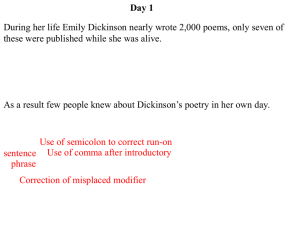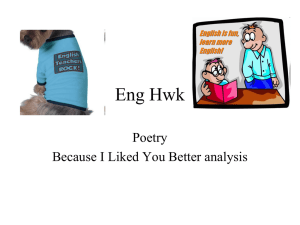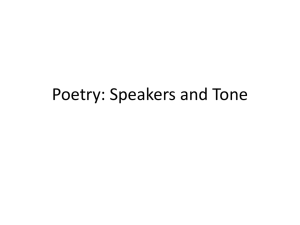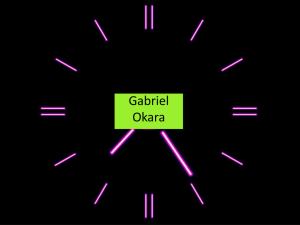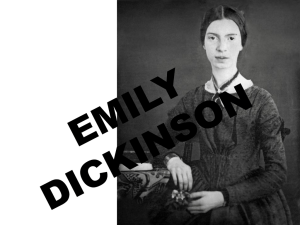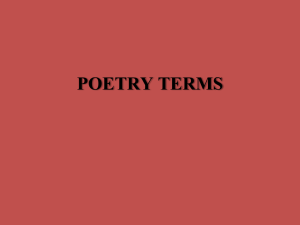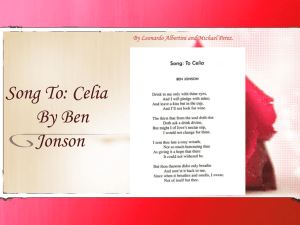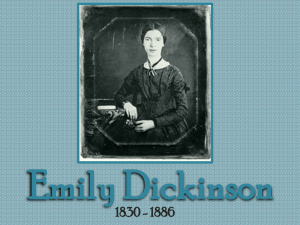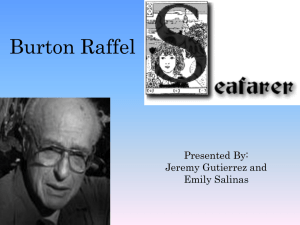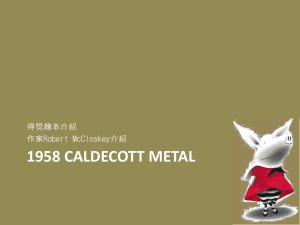I Heard a Fly Buzz - When I Died
advertisement
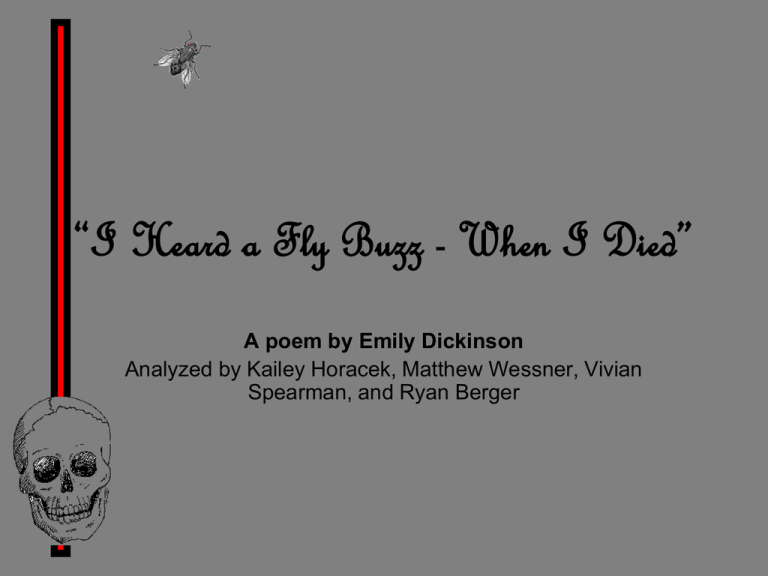
“I Heard a Fly Buzz - When I Died” A poem by Emily Dickinson Analyzed by Kailey Horacek, Matthew Wessner, Vivian Spearman, and Ryan Berger Line 1 I heard a Fly buzz- when I diedOur Interpretation: It is strange that so much attention is being paid to a fly at such a grave moment. We also believe that this line expresses situational irony because a person can not hear if dead. Critic’s Interpretation: Critic Mary K. Ruby states “that the experience in this poem is being described from a unique point of view” (1). She explains that it is rather strange that the narrator would be focusing on something like a fly buzzing at the moment of their death (1). The first line leaves the reader wondering the significance of the fly and why it is “the speaker’s most immediate and enduring memory of the experience of death” (1). Lines 2 - 4 The stillness round my form/ Was like the stillness in the air/ Between the heaves of storm. Our Interpretation: The surroundings of the narrator’s dying body are calm – as calm as the eye of a storm. In the eye of a storm, there is peace, but more tumult is found both before and after the tranquility. Before the eye is the narrator’s life; the storm after the eye is the narrator’s afterlife. Critic’s Interpretation: Ruby reports that the “stillness” is the “absence of movement and noise” in the room (1). “Heaves of Storm” refers to the silence in the eye of a storm; Ruby goes on to apply the metaphor to the idea that the speaker finds herself in between the storms of life and death. Line 5 - 6 The Eyes around-had wrung them dry- /And Breaths were gathering firm Our Interpretation: The people surrounding the speaker cried until tears would no longer come and each breath they took became heavier because they were so overcome with sadness. Critic’s Interpretation: Ruby explains that the “Eyes” literally refers to the eyes belonging to the people mourning over their dying loved one (2). The phrase “had wrung them dry” refers to the fact that the mourners “had cried all the tears that they could during this exhausting death ritual”(2).”Breaths” represents the mourners and each breath they take (2). “Gathering firm” possible means that the mourners “have gathered together to support eachother in the fixed and unalterable understanding that the loved one will die…”(2). Lines 7-8 For that last Onset- when the King/ Be witnessedin the Room Critic’s Interpretation: Our Interpretation: During the last moments in her life God comes to take her soul to heaven. She is growing closer to her final breath, so “God’s presence” is in the room. Ruby states that “that last Onset” most likely means “the final stage of the dying process”(2). She also explains that “because the mourners in the room were most likely to be 19th-century American Protestants, they would have been expecting some formal sign that their loved one has been welcomed into the Kingdom of God, or into the arms of Christ the ‘King.’ Perhaps the speaker recognizes the eagerness of her loved ones to ‘witness’ Christ in the room. This expectation is quite ironic because the poem’s speaker sees not Christ but a common blowfly” (2). Lines 9-12 I willed my Keepsakes—Signed away/ What portion of me be/ Assignable—and then it was/ There interposed a Fly— Our Interpretation: The speaker gave away all that was tangible in their will. While the speaker was thinking over the things they gave away a fly buzzed by. Critic’s Interpretation: Ruby explains that “the speaker describes the completion of personal business as an important part of the dying process”(2). The speaker signed away their “keepsakes” to family members and friends in their will (2). Lines 10-11 most like “refers to the dying person’s request for the memorial ceremony and disposal of the body”(2). Line 12 “could mean that the speaker is interrupted from the social ritual of death by the fly’s presence”(2). Lines 13-14 With Blue—uncertain stumbling Buzz— / Between the light—and me— Our Interpretation: The speaker’s soul is between her physical being and heaven when the fly buzz by and interrupts the process. Critic’s Interpretation: Ruby states that “the color blue is usually [Emily] Dickinson’s symbol for eternity. Here, perhaps it is used ironically because the fly, as a creature that lays its eggs in dead flesh, is usually symbolic of mortality”(2). The fly buzzing is referred to as “uncertain” and “stumbling” could indicate the sound a fly makes when it moves “in and out of human consciusness”(2). In these lines the fly interferes when the speaker begins to enter the “light”(2). The critic then explains “here, the light can have two meanings. Literally, it describes the actual light of day and touches upon the fact that the speaker’s sense of sight is failing at the moment of death. Figuratively, the ‘light’ might mean the light of Christ, or the spiritual world. In any case, it is the sound of the fly that interrupts the speaker’s experience”(2). Lines 15-16 And then the Windows failed—and then/ I could not see to see— Our Interpretation: The “windows” refer to the speaker’s eyes because eyes are often described as “the windows to the soul”. At this point in time, the speaker’s eyes are closing because they are dying. Critic’s Interpretation: Ruby explains that the “Windows” has one of two meanings, “perhaps the speaker is transposing the experience of the light failing (blindness) to the windows, describing the loss of the sense of sight in terms of an external, inanimate object”(2). “Windows” could also be “a metaphor for the eyes, much in the sense that people call eyes the windows of the soul”(2). The last line is quite literally a “description of blindness”(2). It could be the loss of physical vision or it could also be describing spiritual blindness, “indicating that there is no great spiritual vision after death but rather nothingness”(2). The second explanation stays true to “Dickinson’s Reputation as a skeptic”(2). Literary Terms • Symbolism is the use of symbols in order to represent something. Example: “I heard a fly buzz when I died” The fly is symbolic for the soul. “And then the windows failed” Windows is symbolic for the eyes Literary Terms Continued • A simile is an expression which describes a person or thing as being similar to someone or something else using “like” or “as.” Example: “the stillness round my form Was like the stillness in the air Between the heaves of storm.” This is a simile because it compares the stillness in the room to that of the eye of a storm. Literary Terms Continued • An allusion is an indirect reference to someone or something. Example: “for the last onset, when the king Be witnessed in his power.” This is an allusion to God, Jesus Christ, and the Christian religion’s acceptance of the dead. • The whole poem is an extended metaphor of the fly as the soul. An extended metaphor is also a metaphor developed at great length, occurring frequently in or throughout a work. The whole poem is also a metonymy, or a figure of speech used in rhetoric in which a thing or concept is not called by its own name, but by the name of something intimately associated with that thing or concept, for the soul being the fly. The theme of this poem could be considered Dichotomy, or the division between two opposing sides like body and soul. Contribution to American Literature Emily Dickinson significantly altered poetry and created a whole new form of poetry. Experimenting with language and form her poems maintained the outward appearance of quatrains and three iambic feet; Emily Dickinson used the form originally inspired by Isaac Watts. Dickinson blended her own poetic language using words she created and sentences that were grammatically irregular. Dickinson capitalizes nouns regardless of whether they are proper or not as well as adds hyphens before phrases she wants to bring attention to. Her most significant contribution is the contribution of irregularities. Dickinson introduced slant and off rhymes which Higginson initially named irregularities. Slant and off rhymes are near rhymes, oblique rhymes, or rhymes using assonance or consonance on the final consonants. These “deformities” cause the reader to recognize the importance of a line through the shock of an irregular pattern. Emily Dickinson’s Idiosyncrasies • • • • Emily Dickinson usually uses quatrains. “I Heard a Fly Buzz When I Died” is composed of quatrains Many of her poems are composed of borrowed bits of nursery rhymes; the sound, title, and subject of this poem (a fly) sounds, to the non-poetic ear, like a nursery rhyme. Emily Dickinson uses slant rhyme which is a near rhyme, oblique rhyme, or a rhyme using assonance or consonance on the final consonants. This appears in “I Heard a Fly Buzz When I Died” in lines 2 and 4 and 6 and 8. Throughout “I Heard a Fly Buzz When I Died” there are many instances when she adds hyphens to phrases she finds important. In addition she inserts hyphens before phrases she holds significant . Contemporary Relevance This poem should be part of the literary canon taught in high schools because it shows mortality and the acceptance of death. College is approaching and after college, marriage, then children, and eventually death. Death plays a huge part in life. Emily Dickinson’s poem draws the question of what will happen after death; a question on the forefront of any mature mind. Everyone wonders what happens after the heart stops beating and the eyes shut and Dickinson addresses a possibility that the soul can be like a fly, trying to find the light, escaping the body. In high school every person has a developed opinion of what will happen when this life is over, Dickinson’s poem is perfect of a high school level because poses the same question in everyone else’s mind. The End

